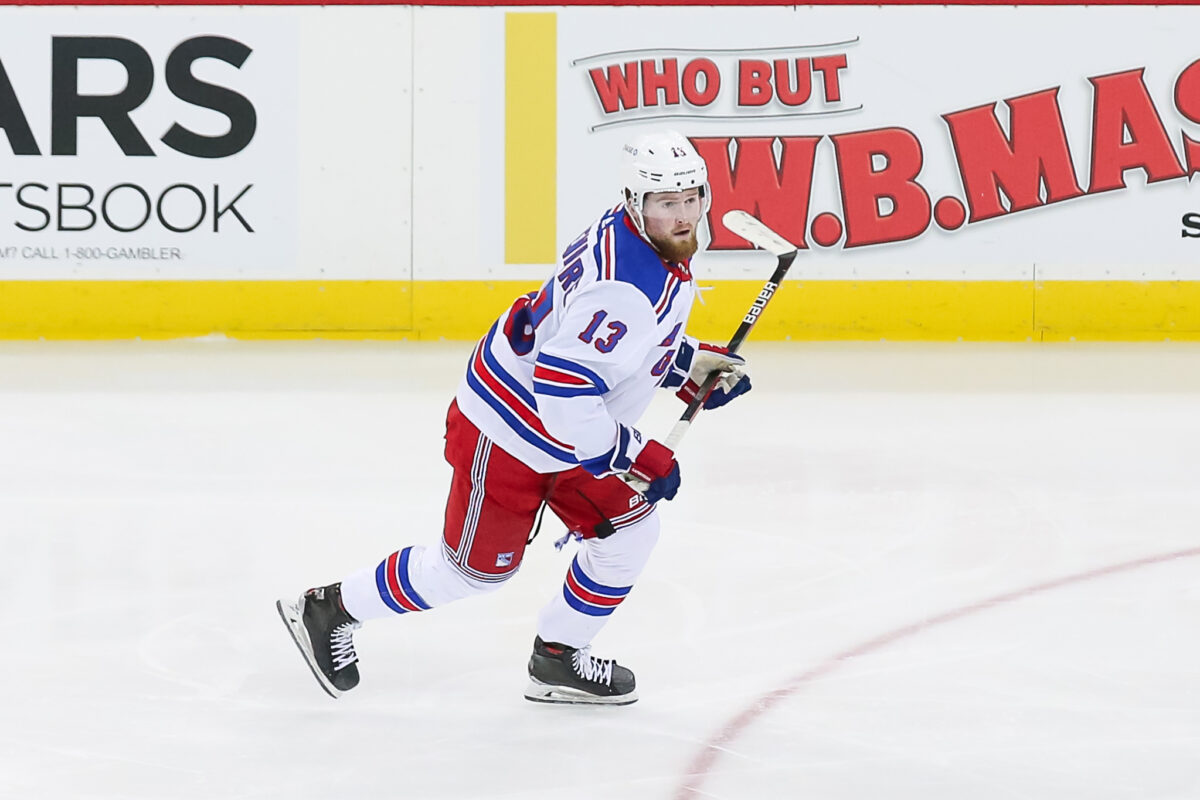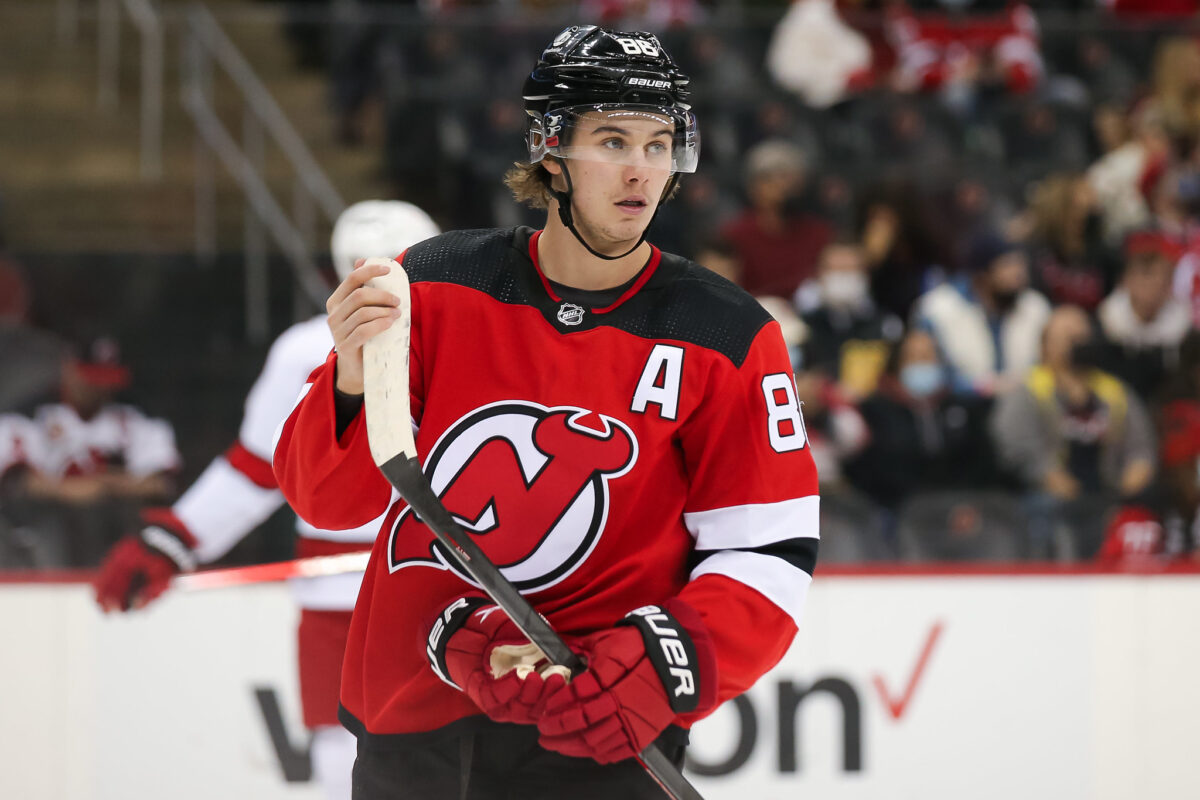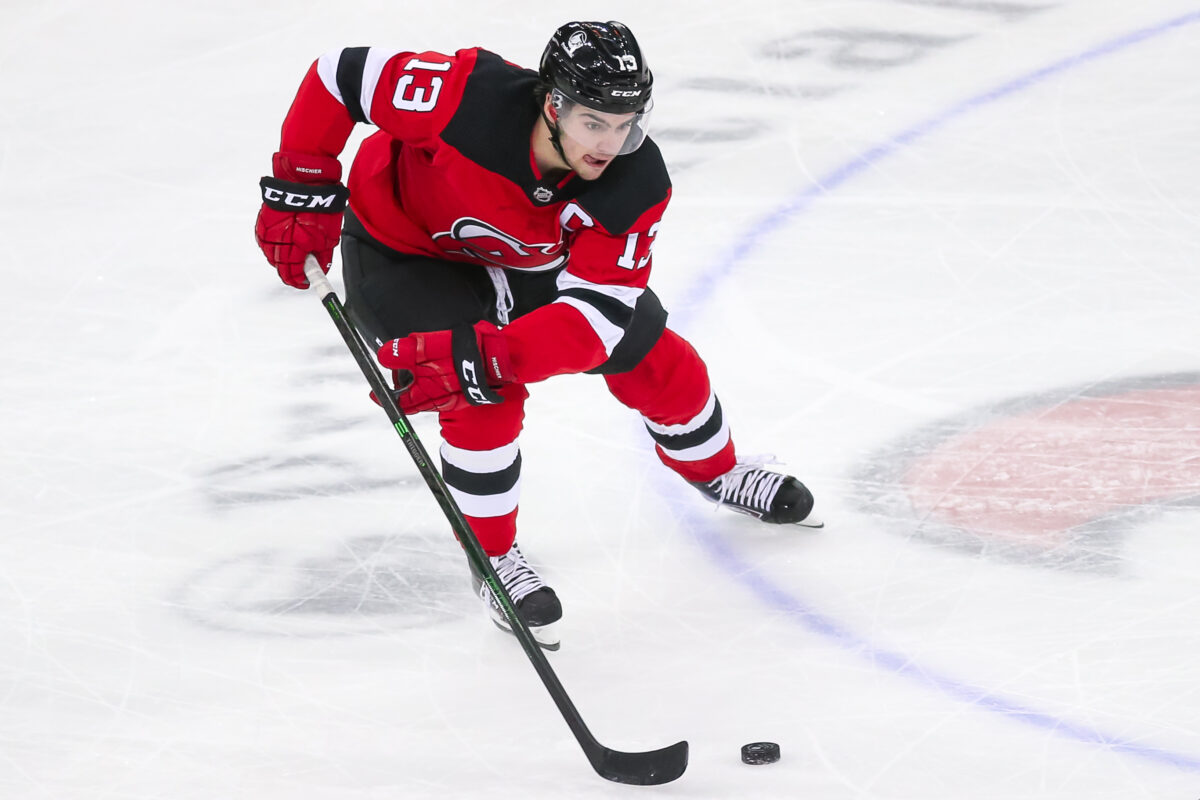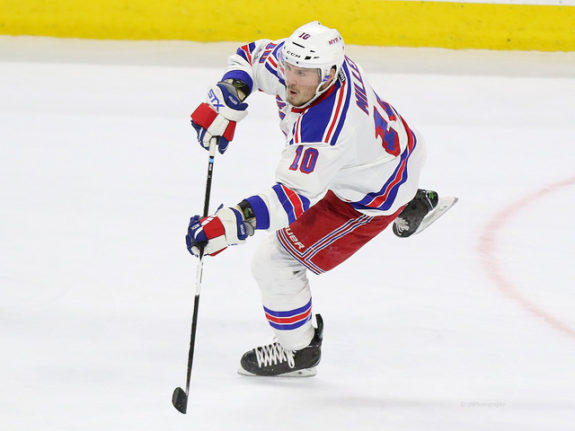The proof that Rangers forward Alexis Lafreniere is starting to grow into a confident NHL player is more than just his increased production that’s come while playing on the Blueshirts’ top line. It’s the body language.
Seventeen months after he was drafted No. 1 overall to great fanfare, Lafreniere is finally carrying himself on the ice with swagger and a bit of brashness, both of which are still re-emerging after clearly being put on, well, ice as the 20-year-old began the challenging transition from junior hockey superstar to NHL mainstay.
Lafreniere has recorded three goals and two assists in his last seven games, during which he’s also compiled a plus-4 rating, leaving him with 13 goals and five assists for the season. He’s meshing with stars Chris Kreider and Mika Zibanejad, and in a critical difference from his rookie season or even earlier in this one, it’s not hard to see that he feels like he belongs on that unit.

That wasn’t the case in his rookie season or even earlier in this one, as the 20-year-old struggled to navigate the waters of the best hockey league in the world. Yet now, the smile after goals is bigger and perhaps more satisfied, the movements on the ice more self-assured, his confidence in his game more apparent.
Lafreniere, like so many other kids who entered the NHL over the past two years, faced an added hurdle to his development: the COVID-19 pandemic. With the virus and the uncertainty that came with it apparently receding around the world, it seems as if Lafreniere’s uncertainty is ebbing as well – leaving behind a rising young player who is finally free to start fulfilling the potential that made him the clear consensus top pick in the 2020 draft.
Kakko Off to Slow Career Start, But Talent Is Apparent
The Rangers have no doubt taken note of the jagged path Lafreniere has taken to reaching their top forward unit, and it would behoove them to continue applying the same patience to fellow draft lottery prize Kaapo Kakko, who has yet to generate any momentum toward NHL stardom amid early-career struggles with consistency and health issues.
Like Lafreniere, Kakko has tantalized with his skills through his 2 1/2 seasons on Broadway since the Rangers made him the second pick of the 2019 draft. Elite hands, a nose for the net and strong work along the walls seem to validate the talent that made him the clear No. 2 prospect in the draft three years ago, right behind top overall selection Jack Hughes of the New Jersey Devils.

However, while Hughes has authored a breakout in his third season, recording 43 points in 37 games to earn himself an eight-year, $64 million contract extension, Kakko is still plugging away at reaching that stratosphere. Actually, the 21-year-old isn’t even doing that right now, having been on injured reserve since Jan. 22 with an upper-body injury and not expected back for at least a couple more weeks.
This is the second time this season Kakko has been put on IR. He also suffers from Type 1 diabetes and celiac disease, and he ended up in the COVID protocol last season, a bit of a scary development for the native of Turku, Finland, as his pre-existing conditions make him more susceptible to severe symptoms stemming from the virus.
Kakko has totaled only five goals and nine assists – three and five of those coming during a seven-game span Nov. 14-Dec. 1 – and 54 points in 151 career games. His rookie season of 2019-20 was something of a nightmare, when he was clearly overmatched by the NHL and finished with a minus-26 rating. He has a tendency to disappear for extended stretches, generally playing a solid all-around game but not producing much, if at all.
Related: Rangers Struggling Without Kakko
His struggles, especially when he’s compared to Hughes, have led to whispers that Kakko, if not a bust, isn’t an elite player-in-waiting, and a segment of the fan base seems to have given up on him. Yet in addition to his teammate Lafreniere, examples abound as to why the Rangers could be making a serious mistake in trading Kakko, be it at the deadline for a high-end upgrade or in the offseason for a second-line center.
Hughes’ trajectory should be an encouraging sign for Kakko’s future. The center also looked lost as a rookie, managing 21 points in 61 games and tying Kakko at minus-26. Hughes improved somewhat in his second season, totaling 31 points in 56 games of the COVID-shortened campaign, before the light went on for him in Year 3.

Kakko also improved in his second season, as his all-around game rose and he finished plus-3 to go with 17 points in 48 contests. Though he hasn’t mirrored Hughes’ ascendance this season, the lesson should be clear: Both players struggled as rookies while also contending with a pandemic that cut their rookie seasons to 70 games, and limited their crucial second seasons to 56.
Rangers’ Handling of Kreider, Miller Should Provide Perspective on Kakko’s Future
The high-end talent for both players is/was there; the unique circumstances surrounding their young careers means that it probably shouldn’t be surprising that it’s going to take more time for Kakko’s to emerge.
A better parallel for Kakko might be Hughes’ teammate Nico Hischier, the top overall pick in the 2017 draft. Hischier, while productive early on, was also plagued by inconsistent play as well as injuries in his second and third seasons. Making that process tougher for Devils fans was having to watch Colorado Avalanche defenseman Cale Makar, who was picked fourth in 2017 and would almost certainly go first in a re-draft, become one of the best players in the league.
Yet Hischier also looks to finally be on the road to star status in this, his fifth season. He’s recorded 16 goals and 22 assists in 50 games, and has piled up eight goals and six assists in his last 11. Where Makar was an instant star, other players take different roads to the top.

Along with Lafreniere and the two young New Jersey centers just across the Hudson River, the Rangers can draw further inspiration for taking the long view with Kakko from an experience in their past that remains relevant in the present. The Blueshirts are among a gaggle of teams interested in acquiring Vancouver Canucks forward J.T. Miller, who could be available before the deadline for what should be a steep price in trade capital.
The Rangers, of course, already had Miller, having drafted him 15th overall in 2011. Over nearly six seasons, however, they grew exasperated with him, feeling his ability to reach his ceiling was hindered by a resistance to coaching, stubbornness and immaturity – something Miller confirmed when asked about his past issues with former Blueshirts coach Alain Vigneault late last month. (From ‘Canucks: Alain Vigneault Gets an Assist on J.T. Miller’s Career Ascension’, Montreal Gazette, 2/28/22)
It’s safe to say Miller’s not holding himself back anymore, having reached rarified air in his career that even the Rangers might not have foreseen. A physical winger who could score during his time in New York, the 28-year-old, following a short stopover with the Tampa Bay Lightning after being given away in a terribly lopsided 2018 deadline deal, has blossomed into one of the most versatile and productive forwards in the league.
Moving seamlessly between wing and center, Miller has recorded 185 points in 178 games over 2 1/2 seasons with the Canucks. He scores goals, wins faceoffs (55.3 percent with Vancouver) and has become an outstanding playmaker as well. At the same time, the nasty edge and heavy game that make him all the more valuable have never disappeared. He’s the envy of plenty of teams – none more so than his original one, which could desperately use the 6-foot-1, 218-pounder in its top six as it looks to bulk up for a playoff run.
Miller’s early-career problems were real, as he admitted to, and the Rangers were coming up on having to decide whether to commit to him with a long-term extension when they traded him to the Lightning. Yet the Blueshirts allowed another home-grown power forward to work through problems – some of which, like Miller’s, were between his ears.

The payoff has been Chris Kreider’s 2021-22 season, in which the 19th pick in the 2009 draft has scored 38 goals in 57 games while putting the self-doubt and overthinking that had been preventing him from reaching his potential behind him (From ‘Inside Chris Kreider’s Rangers Transformation From Streaky Scorer to Leading Man’, New York Post, 1/19/22). Kreider was nearly traded at the 2020 deadline before former general manager Jeff Gorton decided he couldn’t afford to do away with such a sought-after commodity, instead signing Kreider to a seven-year, $45.5 extension that’s now looking like a bargain – at least for this season.
Do the Rangers really want to watch a Miller/Kreider sequel a few years from now, with Kakko having fully tapped into his offensive ability and figuring out how to use his size and strength and great hands around the net for someone else?
COVID-19 Pandemic has Disrupted Development of Kakko, Others
The “immediate elite” of players such as Makar, Connor McDavid, Auston Matthews, Jack Eichel, etc. make it tougher on other high draft picks, conditioning fan bases to expect greatness out of the gate for every talented but raw teenager. Kakko, like Lafreniere, has gone through his formative early years in the NHL having to deal with a nearly unprecedented condition of modern society, one that cut short Kakko’s first season, wiped out Lafreniere’s first training camp and has hovered over both of them ever since.
Hughes, Hischier and now Lafreniere serve as strong evidence that every player and every situation is different, and that patience is often rewarded. The contrasting cases of the Blueshirts’ handling of Kreider and Miller should further drive the point home.
The Rangers could have had Kreider on one top forward unit and Miller the other (and might anyway, if they pay the king’s ransom the Canucks will be right to demand should they decide to trade him), a pair of drafted-and-developed big forwards driving offense as part of a long-term core. Do they want to throw in the towel on the possibility of having another chance at that? Lafreniere, having switched to the right side, might finally be on his way to fully unlocking his abilities. Kakko is a natural right wing who has generally excelled playing on the Artemi Panarin-Ryan Strome unit.
The rival Devils waited for their two top-of-the-draft talents to find their paths. If the Rangers were to ship out Kakko in a few weeks, over the summer or even in a season or two, they’ll hardly be able to claim surprise if he develops into a top player elsewhere, given the significant body of evidence that suggests it would be a mistake.
